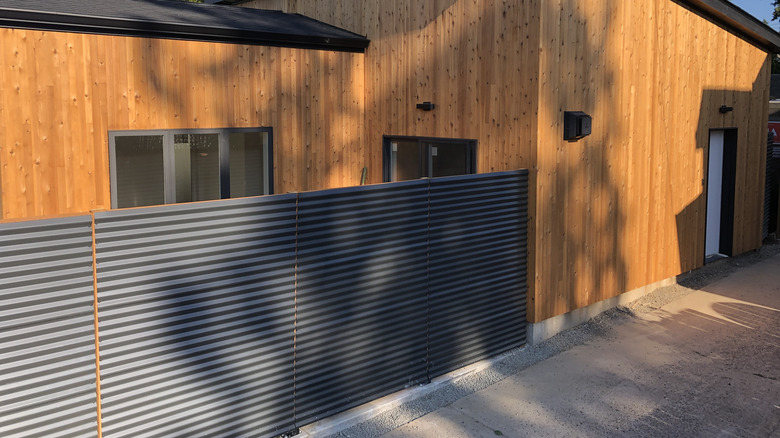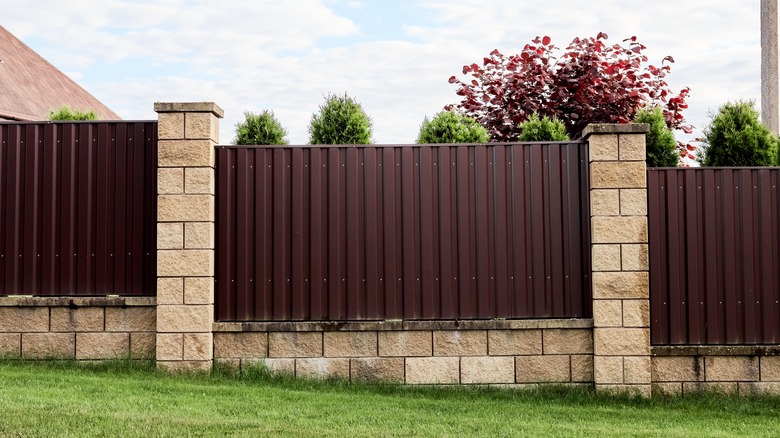This TikTok Creator's Privacy Fence Is Gorgeous, But Is It Actually A Good Idea?
Metal is a little bit addictive. It starts with some metal roofing, or perhaps a garage, and before you know it, you're building a barndominium that looks like a muffler shop before you start adding all the homey touches. But there's one use of corrugated metal that might be a bridge too far. No, not bridges, although that's almost certainly a bad idea. What we're talking about here is fencing. As fashion TikTokker @alliewears shows in a handful of videos, it's possible to make a gorgeous, modern fence using wood posts and the sort of corrugated steel used for roofing. Using this material for privacy fence panels isn't unusual, and they tend to be very stylish in a contemporary/mid-century modern sort of way. But while @alliewears' design blew commenters away, a storm is brewing about whether it will hold up to wind.
The trouble is that there's nowhere for the wind to go but smack into the fence. @alliewears lives in downtown Raleigh, North Carolina, and she installed her $3000, 180-190-foot fence using 7-by-7-foot corrugated panels from ABC Metal Roofing. Each section of the barrier is built with three overlapping panels attached to wood posts that are cemented into the ground. The calculations and considerations required to determine the wind pressure of such a fence design can be daunting for a DIYer. You can certainly cope with this by over-engineering your own supports, but how far should you go? With a solid barrier that obstructs 100% of the wind it encounters, it's virtually impossible to know your design is safe without professional assistance.
Your privacy could be gone with the wind
Most fences reduce their wind load by using materials like lattice, pickets, or slats that are sufficiently spaced apart to allow air through. But more private barriers require a little more attention to closing the gaps between boards. For example, shadowbox fences alternate slats on either side of the posts and bracing to maintain privacy while allowing wind to pass through.
The American Society of Civil Engineers and Structural Engineering Institute identifies wind load limits for structures in various areas of the U.S. Most of the country, including Raleigh, is assigned a limit of 105 mph wind gusts, though some areas are much higher (the southern tip of Florida, for example, experiences gusts at around 170 mph). Given 105 mph winds, the load for a 7-foot-by-7-foot surface is 28.194 pounds per square foot. That is within the allowable load limit for standard 26-gauge PBC panels, and notably more than what's allowed for thinner 29-gauge metal. So, it's possible that @alliewears's fence meets the criteria.
Other ways of ensuring that a fence can withstand strong winds include choosing screws over nails when building it, securely attaching the panels to heavy-duty posts, using shorter panels, installing posts deeper into the ground, and using more post-fixing mix. Reinforcing the panels with angled steel or aluminum braces and horizontal pressure-treated wood crossbars will help as well, as will erecting windbreaks. If you take enough of these measures, you can likely make a solid metal fence work — at least in the right area of the country.
What a nice loud, rusty, dented fence you have there
There are other potential problems with corrugated metal fences that are worth considering. Critics point to limited design options, colors, and profiles. While many look for fencing that will block sound, corrugated metal is known for echoing and amplifying it. It's also prone to denting, rusting, and being both easily damaged and difficult to repair. Oh, and some complain that the metal has sharp edges, as if getting beaned on the head with a wooden fence picket or perforated by chain link is nowhere near as troublesome. None of these are particularly serious concerns — or at least are no more serious than issues with metal buildings (like barndominiums) or roofs. At a minimum, they probably don't offset the benefits of what is a sustainable, durable, low-maintenance, and often quite beautiful material.
There is one other seemingly minor concern that can actually cause a few real problems. Dark-painted metal can reach temperatures up to 240 degrees in full sun. It also gets very cold in winter, so it isn't suitable for areas where you'll make frequent contact with the material. More troublesome is the fact that the constant expansion and contraction of the material can loosen fasteners over time and create gaps between overlapping sheets. This can be exacerbated by the fact that weather changes can shift the posts, all of which can result in a significantly weaker (especially under wind load) fence material.

